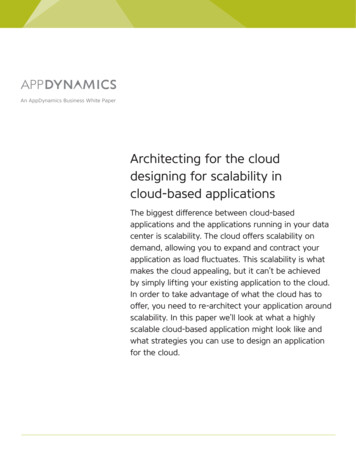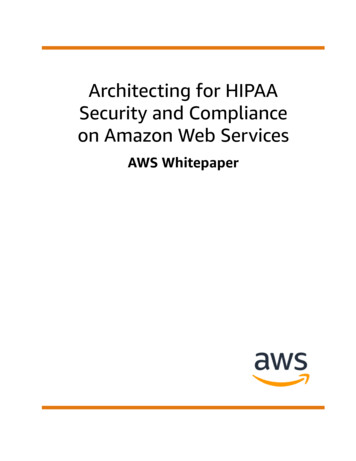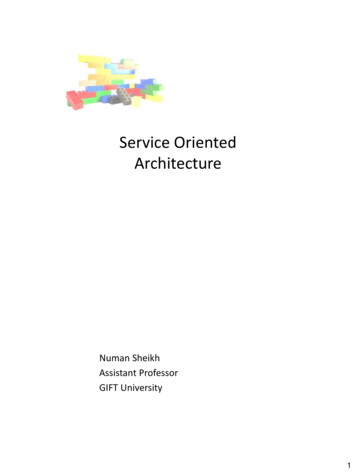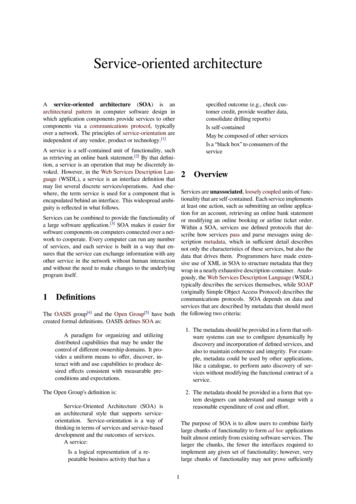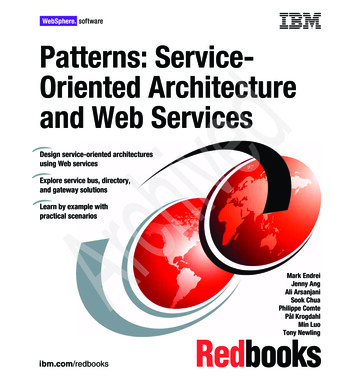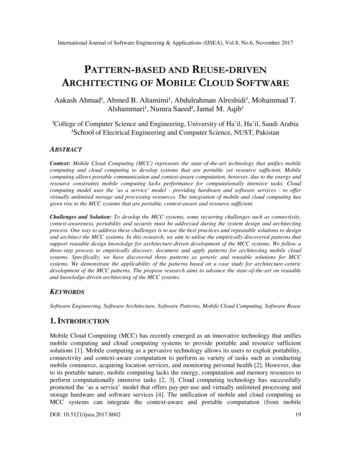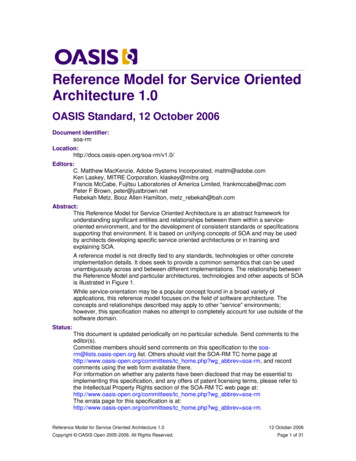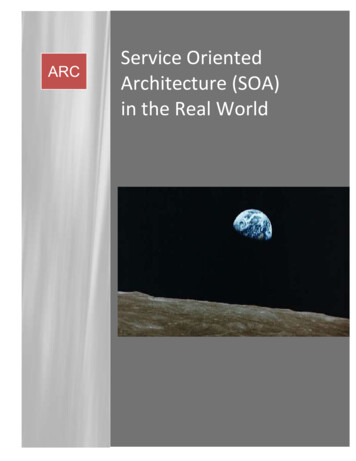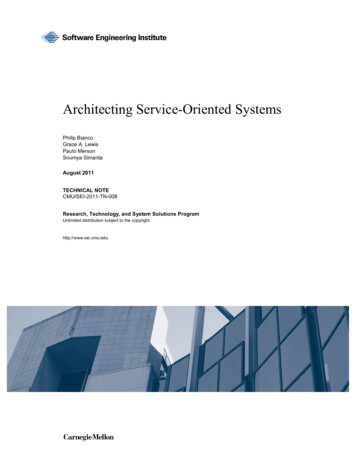
Transcription
Architecting Service-Oriented SystemsPhilip BiancoGrace A. LewisPaulo MersonSoumya SimantaAugust 2011TECHNICAL NOTECMU/SEI-2011-TN-008Research, Technology, and System Solutions ProgramUnlimited distribution subject to the copyright.http://www.sei.cmu.edu
Copyright 2011 Carnegie Mellon University.This material is based upon work supported by United States Department of Defense under Contract No. FA8721-05-C0003 with Carnegie Mellon University for the operation of the Software Engineering Institute, a federally funded research and development center.Any opinions, findings and conclusions or recommendations expressed in this material are those of the author(s) and donot necessarily reflect the views of the United States Department of Defense.This report was prepared for theSEI Administrative AgentESC/XPK5 Eglin StreetHanscom AFB, MA 01731-2100NO WARRANTYTHIS CARNEGIE MELLON UNIVERSITY AND SOFTWARE ENGINEERING INSTITUTE MATERIAL ISFURNISHED ON AN “AS-IS” BASIS. CARNEGIE MELLON UNIVERSITY MAKES NO WARRANTIES OF ANYKIND, EITHER EXPRESSED OR IMPLIED, AS TO ANY MATTER INCLUDING, BUT NOT LIMITED TO,WARRANTY OF FITNESS FOR PURPOSE OR MERCHANTABILITY, EXCLUSIVITY, OR RESULTSOBTAINED FROM USE OF THE MATERIAL. CARNEGIE MELLON UNIVERSITY DOES NOT MAKE ANYWARRANTY OF ANY KIND WITH RESPECT TO FREEDOM FROM PATENT, TRADEMARK, OR COPYRIGHTINFRINGEMENT.This material has been approved for public release and unlimited distribution except as restricted below.Internal use:* Permission to reproduce this material and to prepare derivative works from this material for internal use isgranted, provided the copyright and “No Warranty” statements are included with all reproductions and derivative works.External use:* This material may be reproduced in its entirety, without modification, and freely distributed in written orelectronic form without requesting formal permission. Permission is required for any other external and/or commercialuse. Requests for permission should be directed to the Software Engineering Institute at permission@sei.cmu.edu.For information about SEI publications, please visit the library on the SEI website (www.sei.cmu.edu/library).*These restrictions do not apply to U.S. government entities.SEI markings v3.0 / 19 July 2011
Table of ContentsAbstractvii1Introduction12Summary of Existing Work2.1 SOA Design Patterns2.2 Evaluating SOA2.3 SOA Layers33353SOA Architectural Principles3.1 Standardization (Interoperability)3.2 Loose Coupling3.3 Reusability3.4 Composability3.5 Discoverability89111314154Common Components of a Service-Oriented System4.1 Enterprise Service Bus181854.24.1.1 Supporting Patterns and Tactics4.1.2 Impact on System QualityService Registry and Repository1820214.34.2.1 Supporting Patterns and Tactics4.2.2 Impact on System QualityMessaging System2223234.44.3.1 Supporting Patterns and Tactics4.3.2 Impact on System QualityBusiness Process Engine2325264.54.4.1 Supporting Patterns and Tactics4.4.2 Impact on System QualityMonitoring and Management orting Patterns and TacticsImpact on System Quality3132CMU/SEI-2011-TN-008 i
CMU/SEI-2011-TN-008 ii
List of FiguresFigure 1:SOA Layers6Figure 2:High-Level Notional View of a Service-Oriented System8Figure 3:WS* Web Services Protocol and Standards Stack10Figure 4:ESB Patterns and Sub-Patterns (adapted from [Erl 2009])19Figure 5:Asynchronous Messaging Pattern, Specializations, and Sub-Patterns25Figure 6:Orchestration Pattern and Sub-Patterns (adapted from [Erl 2009])27CMU/SEI-2011-TN-008 iii
CMU/SEI-2011-TN-008 iv
List of TablesTable 1:Effect of Standardization10Table 2:Effect of Loose Coupling12Table 3:Effect of Reusability13Table 4:Effect of Composability15Table 5:Effect of Discoverability16Table 6:ESB Aspects that Negatively Affect System Qualities20Table 7:ESB Aspects that Positively Affect Systems Qualities21Table 8:Service Registry and Repository Aspects that Negatively Affect System Qualities23Table 9:Service Registry and Repository Aspects that Positively Affect System Qualities23Table 10:Messaging System Aspects that Negatively Affect System Qualities25Table 11:Messaging System Aspects that Positively Affect System Qualities26Table 12:Business Process Engine Aspects that Negatively Affect System Qualities28Table 13:Business Process Engine Aspects that Positively Affect System Qualities28Table 14:Monitoring and Management Tools Aspects that Negatively Affect System Qualities30Table 15:Monitoring and Management Tools Aspects that Positively Affect System Qualities30CMU/SEI-2011-TN-008 v
CMU/SEI-2011-TN-008 vi
AbstractService orientation is an approach to software systems development that has become a popularway to implement distributed, loosely coupled systems, because it offers such features as standardization, platform independence, well-defined interfaces, and tool support that enables legacy system integration. From a quality attribute point of view, the primary drivers for service orientationadoption are interoperability and modifiability. However, a common misconception is that an architecture that uses a service-oriented approach can achieve these qualities by simply putting together a set of vendor products that provide an infrastructure and then using this infrastructure toexpose a set of reusable services to build systems. In reality, there are many architectural decisions that need to be made. An architectural decision that promotes interoperability or modifiability can negatively impact other qualities, such as availability, reliability, security, and performance. The goal of this report is to present general guidelines for architecting service-orientedsystems, how common service-oriented system components support these principles, and the effect that these principles and their implementation have on system quality attributes.CMU/SEI-2011-TN-008 vii
CMU/SEI-2011-TN-008 viii
1 IntroductionDespite a highly publicized report that claimed that “SOA is Dead,1” the reality is that serviceoriented architecture (SOA) is still a popular architectural style for designing and developing distributed systems. As with any architectural style, SOA can be described in terms of the importantarchitectural elements and the relationships among them. In this report, we examine how the design of these elements and their relationships impact system quality.Solutions that use a service-oriented2 approach are intended to satisfy business or mission goalsthat include quality requirements such as easy and flexible integration with legacy systems (interoperability), streamlined business processes (maintainability), reduced costs (modifiability), andagility to handle rapidly changing business processes (extensibility). These are the primary architectural drivers addressed by SOA adoption, and are achieved by adhering to a set of design principles for service-oriented systems that will be described later in the report. However, there areother important quality attributes such as availability, reliability, security, and performance thathave to be addressed. In addition, an architectural decision that promotes one of these qualityattributes can negatively impact any other quality attribute.As an architectural pattern, SOA is an appropriate solution in some situations; however, there aresituations in which it is not appropriate or in which it has to be used in conjunction with othertechnologies to achieve desired system qualities. A few examples of situations when SOA maynot be appropriate include the following: In a solution that does not require the integration of components or systems running on different platforms, or implemented using different technologies, service orientation may beoverkill because there is an overhead for the use of SOA technologies to provide interoperability across platforms. For a system built on a homogenous development platform with few interactions with legacysystems running on different platforms in which the situation is not likely to change, a movetowards service orientation is hard to justify. If a system consists of co-located components or distributed components that interact viaemail messages, file sharing or proprietary messaging systems, the sophisticated integrationmechanisms provided by SOA may introduce an unnecessary burden. Hard real-time systems are clearly not a good match for service orientation. Strict timelinessrequirements conflict with several aspects of common technologies used in service-orientedsystems (e.g., web services) that may introduce unbounded overhead in processing, such asextensible markup language (XML) parsing, validation, and transformation; network -dead-long-live-services/comments/page/2/2We use the term service-oriented system to separate SOA as a set of technologies from service-orientation asa system or approach that incorporates and applies SOA-related concepts and technologies.CMU/SEI-2011-TN-008 1
munication; proxies and stubs for technology adaptation; and intermediary components (e.g.,a service registry or an enterprise service bus [ESB]). Embedded systems are not naturally fit to host service-oriented systems. Embedded platforms have limited computing power, memory, and disk resources. Many SOA technologiesare heavyweight in terms of memory and CPU requirements. Thus, designing a SOA solution for the software on a washing machine or a video-game console can bring unneededcomplication and overhead.Architects therefore play a crucial role in determining what expectations can or cannot be met bySOA adoption, and where decisions can be made for the benefit of the organization and the accomplishment of system quality attributes. Reasoning about these difficult decisions can be simplified by using known solutions for promoting quality attributes that are important to the systems’ stakeholders. These known solutions are often codified as architectural patterns and tactics.An architectural pattern “deals with a specific, recurring problem in the design of a software system to construct architectures with specific properties [Buschmann 1996].” Architectural patterns are used to generate designs that are predictable and well understood. Architectural patternscan be decomposed into a set of architectural tactics. Architectural tactics are design decisionsthat are known to influence quality attribute responses [Bass 2003]. An example of a tactic is tointroduce redundancy to promote system availability by reducing system downtime (e.g., systemavailability rises from 99.0% to 99.9% when a redundant element is added).The goal of this report is to show architects of service-oriented systems how to decompose thesesystems into a set of architectural patterns and tactics that promote important system quality goals.Section 2 summarizes existing related work. Section 3 presents a set of SOA architectural principles that are realized through patterns and tactics. Section 4 presents the common elements of aservice-oriented system, how these elements support the SOA architectural principles, and thesystem qualities that these elements promote.CMU/SEI-2011-TN-008 2
2 Summary of Existing WorkA common misconception (mostly vendor driven) is that simply by adopting a SOA strategy oreven acquiring a SOA infrastructure, an organization has established a complete well-crafted architecture that will help the organization achieve its many business goals [Lewis 2007]. In reality,SOA is an architectural pattern from which an infinite number of architectures can be derived—both good and bad. Appropriate decisions regarding tradeoffs are very specific to the system inconsideration, providing one more reason why organizations make a mistake in assuming thatSOA represents a “finished” architecture. This section summarizes existing work that addressesthe architecture and design of service-oriented systems as a key activity in the implementation ofservice-oriented systems. Our report builds on this existing work to provide guidance for architects that need to make design decisions in service-oriented systems.2.1SOA Design PatternsArchitectural patterns are used to generate designs that are predictable and well understood. Thesepatterns leverage knowledge and experience to produce proven solutions to recurring design problems. The book SOA Design Patterns by Thomas Erl (with contributions from over thirty practitioners) as well as the SOA Patterns website, describe approximately eighty-five patterns for service-oriented systems. The goal of SOA design patterns is to provide a “master catalog andpattern language for SOA” for practitioners that are designing a system using service orientation[Erl 2009]. Some of these patterns have been described in other work, such as Design Patternsand Pattern-Oriented Software Architecture [Gamma 1994, Buschmann 1996]. Thomas Erl showshow these patterns relate to the principles of service-oriented design. Examples of patterns include Patterns for the infrastructure needed to support service orientation, such as Enterprise Service Bus (ESB) and Service Registry Patterns for creating inventories of services, such as Service Normalization and Service Layers Patterns for composing services, such as Entity Abstraction, Agnostic Context, CapabilityComposition, and Enterprise Inventory Patterns for reliable messaging, such as Reliable Messaging Patterns for atomic distributed service transactions, such as Atomic Service Transaction Patterns for security, such as Brokered Authentication, Data Origin Authentication and DataConfidentiality Patterns for encapsulating legacy systems, such as Legacy Wrapper and Service Messaging2.2Evaluating SOAEvaluating the architecture of a service-oriented system is not much different from evaluating anyother kind of software architecture. The goal is to assess the ability of the software architecture tosuccessfully address the requirements of the system or, more broadly, the business goals. The basic principles for the evaluation of any software architecture using a business-goal and quality-CMU/SEI-2011-TN-008 3
attribute-based approach, such as the Architecture Tradeoff Analysis Method (ATAM ) [Bass2003], include Quality attribute requirements shape the architecture. If achievement of functionality werethe only requirement, the system could exist as a single monolithic module with no internalstructure at all [Bass 2003]. However, components and infrastructure elements are replicatedbecause of availability requirements, concurrency is introduced, network and database accessare avoided because of performance requirements, modules are organized into layers becauseof modifiability requirements, and so on. Therefore, a software architecture can only be evaluated if the quality attribute requirements are understood. A broad group of stakeholders need to be involved in the elicitation of quality requirementsbecause they bring together a variety of disparate concerns that the architect might overlook.Network administrators may have specific requirements for bandwidth utilization; information security personnel may bring new confidentiality requirements; the database administrator may want to constrain the execution time of data access operations; an external serviceconsumer may have interoperability requirements; and so on. Design decisions often incur quality attribute tradeoffs. In a software architecture evaluation,the appropriateness of each design decision is weighed only after the importance of eachquality attribute requirement is understood. Because architectural decisions tend to have a pervasive effect on implementations and havea significant impact on business, performing an early architecture evaluation is particularlyvaluable and recommended. When a system includes connectivity with other systems and business entities, the politicalforces involved with this connectivity can be as important as both technical and nontechnical concerns in architecture tradeoff considerations.These architectural evaluation principles can be applied to service-oriented systems because thesesystems are often part of technologically diverse environments that involve a large number of design considerations. Examples of SOA-related design decisions that are explored during an evaluation and should be considered during the design process include What communication protocol should be used between each pair of service consumer andservice provider? What integration approach should be followed? ESB-based or direct point-to-point? Should an orchestration server (e.g., a business process execution language [BPEL] engine)be used? Should a service registry be used? What capabilities besides naming and location would itprovide? Should a defined service operation be synchronous or asynchronous? What is the appropriate granularity for the operations in each service interface? What are the system strategies for exception handling and fault recovery? Architecture Tradeoff Analysis Method and ATAM are registered in the U.S. Patent and Trademark Office byCarnegie Mellon University.CMU/SEI-2011-TN-008 4
Should message-level security be used to protect messages? Or is channel-level securityenough? What authentication and authorization mechanisms will be used? What service versioning mechanism will be used?Evaluating a Service-Oriented Architecture [Bianco 2007] discusses the design decisions listedabove and several others, but also provides the pros and cons of the different design alternativeswith respect to various quality attributes. For example, static service binding (with no registry)yields better response time, whereas dynamic service binding (with a registry) incurs a performance overhead but yields better modifiability. The report also lists sample design questions thatcould be raised in an architecture evaluation and during the design of a service-oriented system tomake sure that different quality requirements are addressed. Some examples of these questions are Which standards does the supporting platform implement? Can this particular service operation be called asynchronously? Do operations in the service interfaces map to transactional boundaries? How stable is the business process that will be executed in the service-oriented system? Which types of failures is the system subject to? Does the architecture provide a mechanism (e.g., digital signatures) to ensure that a thirdparty will not intercept and alter message contents (tampering)? What kind (e.g., lightweight directory access protocol [LDAP]-based) and scope (e.g., enterprise-wide) of security domain are going to be used for managing the identity of participating users and systems? Can XML validation be turned off? Is a registry being used? If so, is it used for dynamic routing of service calls (e.g., for failover)? If an orchestration engine is being used, does it generate audit trails that support transactiontraceability and regulatory requirements? How long should old versions of services/operations be available? What is the unit of versioning? Service or operation within a service?2.3SOA LayersThere are many sources that provide a form of reference architecture or layered approach for systems that use a service-orientation approach [Bieberstein 2008, Arsanjani 2004]. These layers facilitate separation of concerns, and designers have a set of architectural decisions that need to bemade in each layer. Figure 1 shows the typical layers of a service-oriented system that are primarily functional in nature.CMU/SEI-2011-TN-008 5
Figure 1: SOA LayersThis service-oriented system includes the following layers: Presentation—The benefit of creating a presentation layer is decoupling the client-side presentation implementation from the service implementation to allow each to change independently. This layer is generally not the focus of service-oriented design. Business process—The services provided in the services layer are often composed intoworkflows to assist in the development of applications. This provides flexibility to changethe workflows as business processes change. Services—Services reside in this layer. The invocation of these services can be determined atdesign time or bound dynamically through a service registry at runtime. These services arebroken into additional layers to assist in the composition of services into complete businessprocesses. The additional layers include: Utility-based services, which provide utility-based functions such as notification, logging and exception handling. These operations are largely agnostic to business processesand can therefore be reused in multiple business processes.Entity-based services, which operate on a set of business entities (or data entities). Theseoperations are largely agnostic to business processes and can therefore be reused in multiple business processes.Task-based services, which are “business services with a functional boundary directlyassociated with a specific parent business task or process” [SOA Methodology 2010].CMU/SEI-2011-TN-008 6
Enterprise—These components contain code that specifically fulfills service needs or codethat accesses the functionality in operational systems. “These special components are a managed, governed set of enterprise assets that are funded at the enterprise or the business unitlevel. This layer typically uses container-based technologies such as application servers toimplement the components, workload management, high-availability, and load balancing”[IBM 2004]. Operational Systems—This layer consists of existing custom-built, commercial, externalsystems or some combination of these. Careful analysis of these systems needs to be completed to determine the operations that should be exposed as services. These services areconsidered to have enterprise-wide utility.Many reference architectures provide additional layers for integration, governance, monitoring,and management, as will be discussed in Section 4.5.CMU/SEI-2011-TN-008 7
3 SOA Architectural PrinciplesSOA architectural principles are general guidelines for architecting service-oriented systems.These principles are ideally enabled by the decisions found in the architecture of the system. In aservice-oriented architectural pattern we characterize explicit boundaries between its four maintypes of elements: service consumers, SOA infrastructure, service interfaces, and service implementation, as shown in Figure 2.3Erl and others have defined additional principles for service design [Erl 2008]. The principles inthis section are similar, but they apply to the full architecture of the service-oriented system: theintegration of services (interface and implementation), service consumers, and the SOA infrastructure. Each principle contains a short description and a table that explains the effects that eachprinciple has on selected system quality attributes.End rService ConsumersSOA ceDService InterfacesEnterpriseInformation SystemLegacy or NewService CodeInternal UsersExternalSystemServiceImplementationFigure 2: High-Level Notional View of a Service-Oriented SystemArchitects of service-oriented systems often find themselves in a conflict. On one hand, there arebusiness/mission goals and quality attribute requirements driving the architecture of a system. Onthe other hand, there are principles of service-orientation that influence the architecture of a system and impact a system’s quality attributes. It is at this intersection of these two sets of qualityattributes where conflicts arise and an architect needs to make decisions. The responsibility of thearchitect is to try to apply each principle in the context of the business goals of the system and tomake the necessary tradeoffs and architectural decisions in order to meet the system’s business3Figure 2 is a much more generic representation of the elements shown in Figure 1. The goal of Figure 2 is toillustrate the four major elements of a service-oriented system, independent of implementation technologies.CMU/SEI-2011-TN-008 8
goals. It is important to note that the impact on quality is not binary (positive or negative) becausespecific system context may impact the effect on quality attributes of interest. The informationcontained in each of the following subsections reflects general trends.3.1Standardization (Interoperability)One of the enablers of widespread SOA adoption, especially in the case of WS* web services,4 isstandardization at multiple levels, as shown in Figure 3. Standardization in service-oriented systems has multiple advantages including tool support and leverage of third-party system components that in the end can lead to shorter development times.The WS* base stack (HTTP, XML, SOAP, and WSDL) is fairly stable and has large tool support.For example, there are multiple tools that will take a web service definition language (WSDL)document as input and produce all the code necessary to invoke the associated service. However,beyond the base stack it is not that straightforward because of the over-abundance of standards.There are currently over 100 WS* standards produced by organizations such as OASIS and W3Cin areas that include business process specification, composition, messaging, reliable messaging,transaction management, security, and management. Some of these standards are complementaryand some are competing. In addition, many of these standards have extensions, as well as areasthat can be interpreted in multiple ways [Lewis 2008a].The Web Services Interoperability Organization (WS-I) is an organization chartered to promoteweb services interoperability across platforms, applications, and programming languages [WS-I2010]. WS-I has profiles for the basic stack and for security to provide clarifications, refinements,interpretations, and amplifications in areas of the standards that are subject to multiple interpretations. There are also tools to check that artifacts (e.g., a WSDL file) and actual messages beingexchanged are in conformance with the profiles. The WS-I tools are especially useful in cases inwhich WSDL and XML files are automatically generated and may not conform to the assumptions of the development and deployment environment, e.g., different XML schema versions, different namespaces, malformed XML, etc. The tools that facilitate the usage of these standards willbe one criterion that an architect uses to select between competing standards.4In WS-* Web services, (1) data is represented using XML, (2) service interfaces are described using Web Services Description Language (WSDL), (3) payload is transmitted using Simple Object Access Protocol (SOAP)over Hypertext Transfer Protocol (HTTP), and, optionally, (4) Universal Description, Discovery and Integration(UDDI) is used as the directory service. In addition, although not part of the basic implementation, there areover 100 standards to support other system qualities such as WS-Security for security and WSReliableMessaging for reliability.CMU/SEI-2011-TN-008 9
ManagementTransactionsQuality of ServiceSecurityFigure 3: WS* Web Services Protocol and Standards StackThe following table summarizes how standardization—in aspects such as service description, service discovery, message formats, encoding, and transport—impacts quality attributes in a serviceoriented system.Table 1:Effect of StandardizationQuality eStandardization in service-oriented system implementations is the primary enablerof interoperability, both across platforms and vendors. However, policies andstandards have to be in place to increase interoperability through consistency(e.g., service interfaces, data models, implementation technologies, and versionsof infrastructure elements).ModifiabilityPositive Standardization at the service interface level enables service providers tochange service implementations (e.g., to port a service implementation to anew language) without a major effect on service consumers, as long as theservice interface and the expected behavior of the implementation remain unchanged. Standardization at the infrastructure level, mainly for integration between components, enables infrastructure components5 to change as technologychanges without as many effects on consumers. The use of XML as a form of standardization provides flexibility in contractspecification to deal with changes without having major effects on service consumers (e.g., new elements in an XML schema can be made temporarily optional, XML schemas can have extension points if certain changes are anticipated).Infrastructure components are elements of the SOA infrastructure shown in Figure 2. Examples of an infrastructure component include ESB, service registry, load balancer, and monitoring tools.CMU/SEI-2011-TN-008 10
Quality AttributeEffectExplanationPerformanceNegative The use of XML for standardization in most service-oriented implementationshas a negative effect on performance because XML involves three CPUintensive activities: parsing, validation, and transformation [Juric 2004]. Some standards (e.g., SOAP) require bridges, proxies, stubs, and similar elements to perform transformations and translations that are needed for interoperability.ReusabilityPositive Standardized service interfaces enable services to be used across multiplebusiness and operational processes. However, proper service identificationprocesses have to be in place such that all services represent independentand cohesive business/operational tasks. Standards are often used to promote reuse between service providers andconsumers that use heterogeneous technologies. However, the parsing ofthese standard formats incurs significant runtime overhead w
2.1 SOA Design Patterns Architectural patterns are used to generate designs that are predictable and well understood. These patterns leverage knowledge and experience to produce proven solutions to recurring design prob-lems. The book SOA Design Patterns by Thomas Erl

